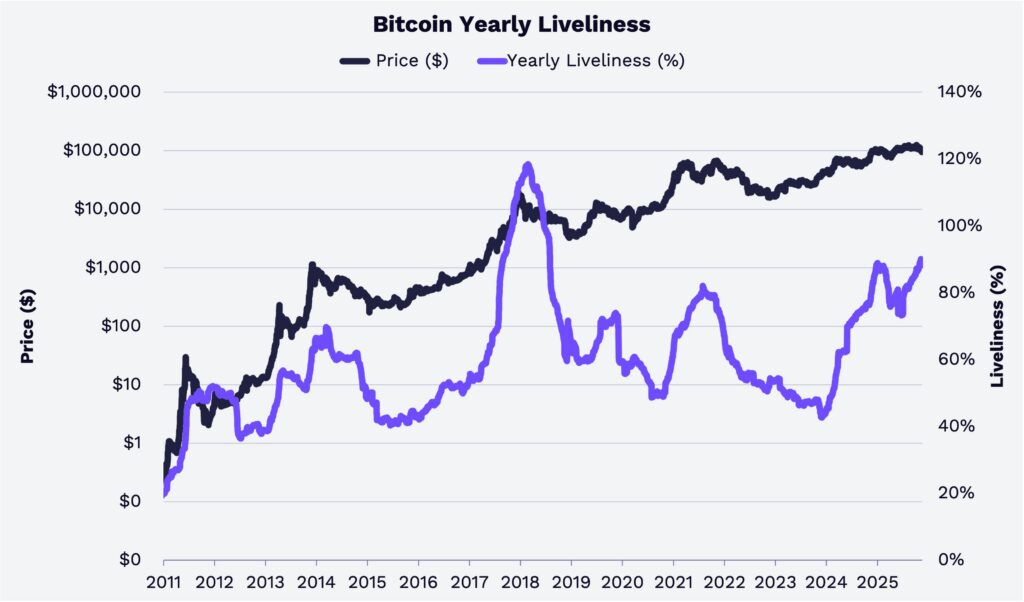
Bitcoin's price is losing ground and trading near $90.000, while ARK Invest identifies a historic transfer of ownership: veteran investors are selling and institutions are massively absorbing the supply.
Bitcoin's price recently fell below the psychological barrier of $90.000, before recovering to around $92.000, a move that at first glance might be interpreted as a sign of market weakness. However, behind the losses and daily volatility seen this week lies a much more complex phenomenon that is redefining the very structure of the leading cryptocurrency.
According to the most recent analysis by ARK Investment Management, published on November 17, what we are witnessing is not a capital flight, but a generational wealth transfer from early adopters to institutional giants on Wall Street.
The report suggests that the crypto market is undergoing a restructuring phase. David Puell, trading analyst at ARK Investment, describes the current situation as a battle of opposing forcesOn one hand, investors who entered the ecosystem years ago are taking advantage of historic prices to realize gains; while on the other hand, exchange-traded funds (ETFs) and public companies are acting as a safety net, absorbing the available supply at a rate that rivals the selling pressure.
Bitcoin trades as Wall Street absorbs BTCThe awakening of Bitcoin's dormant coins
To understand the magnitude of the selling that has pushed Bitcoin's price down, it is necessary to observe the behavior of so-called "whales" or long-term holders.
The ARK Investment report highlights a significant uptick in the metric known as "liveliness" or livelinessThis indicator, which tracks the activity of coins that have remained dormant for long periods, is currently at 0.89, its highest level since 2018. Simply put, this means that bitcoins that have been stored in cold wallets for years are waking up and moving towards asset exchange platforms to be liquidated.

According to reportThe "domed" or stagnant supply of Bitcoin has steadily decreased throughout 2024 and 2025. At the beginning of 2024, there were almost 8 million BTC that hadn't moved in a long time; by November 15, 2025, that number had dropped to 7,32 million. While the difference isn't huge, it does represent a active benefit-taking by those who invested in the cryptocurrency in its early stages. Analysts consider this a natural market cycle behavior, as those who accumulated at low prices seek liquidity after the massive price increases of recent years.
This selling pressure, according to ARK Investment, explains the resistance Bitcoin's price has encountered in maintaining its recent highs. When such a large amount of old supply floods the market, immense demand is required to prevent a deeper correction. And it is precisely here that the buyer profile has changed radically compared to previous cycles.
Wall Street acts as a counterweight
While Bitcoin pioneers are selling, institutional capital is buying at record levels. Puell emphasized that the narrative of corporate adoption has ceased to be a promise and has become a reality. tangible market support.
Since their launch in January 2024, US spot Bitcoin ETFs have gone from zero holdings to accumulating over 1,50 million BTC by the end of October this year. If we add to this the holdings of publicly traded companies that have adopted cryptocurrency reserve strategies, the combined figure rises to almost 2,65 million bitcoins under institutional management.

Source: Bitcoin Treasuries
ARK Investment's analysis suggests that institutional demand has largely offset the sell-off by long-term investors. In less than two years, ETFs and corporations have absorbed approximately 1,47 million bitcoins. This figure is key to understanding why the market, despite falling below the $90.000 level, maintains a robust structure. In past cycles, a sell-off of this magnitude by long-term holders typically triggered prolonged crypto winters and much more severe percentage drops. However, today, the presence of regulated players with substantial capital is mitigating the impact.
In light of this, analysts point to a clear maturation of the Bitcoin ecosystemOnce considered an asset exclusive to tech enthusiasts or proponents of alternative financial philosophies, Bitcoin is gaining traction as a legitimate asset class integrated into global portfolios. While volatility persists, market fundamentals appear to be supported by institutional investors with more stable and longer-term strategic visions and investment horizons than the traditional retail investor.
Create your account: access the BTC institutional cycleTowards a new liquidity environment
Looking ahead, the implications of this transfer of ownership are profound. ARK Investment Management projects that, if macroeconomic conditions evolve favorably, this bull market could extend well into 2026. The key will lie in monetary policy and the liquidity of the US dollar. Institutional investors are highly sensitive to interest rates and the availability of cheap capital.
With quantitative easing expected to end and interest rates falling further this year, the stage is set for institutional demand to finally overcome early-stage selling pressure. If global liquidity improves, the buying power of ETFs and corporations could increase, acting not only as support but also as a catalyst for new price discoveries.
In summary, the report suggests that, although Bitcoin's momentary drop below $90.000 may generate alarmist headlines, fundamental data indicates that the health of the crypto market remains intact.

Basic Bitcoin Course
Basic levelStart from scratch in Bitcoin in a clear, easy, safe and quick way. This course is specially designed for beginners practically know nothing about Bitcoin.


